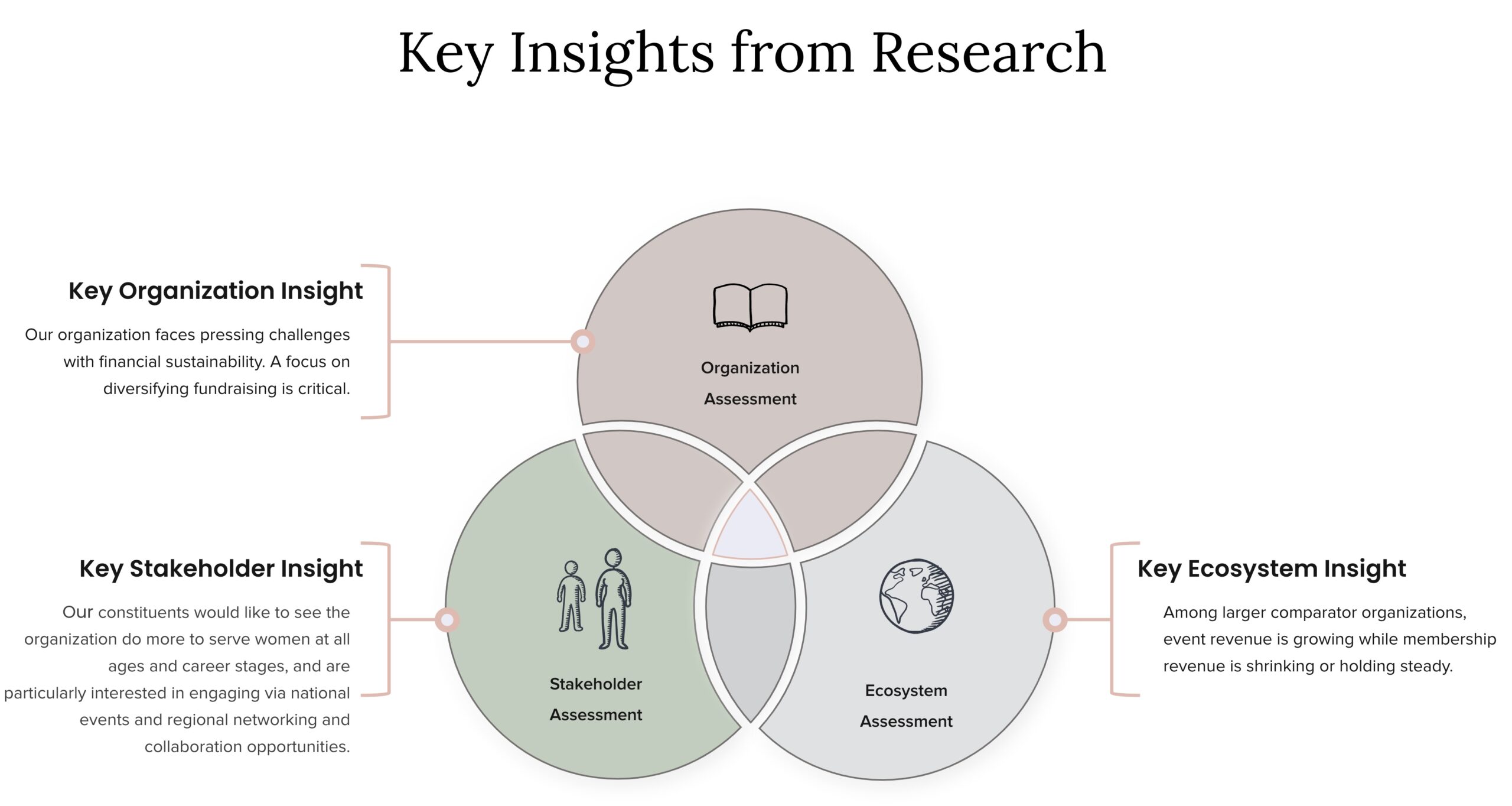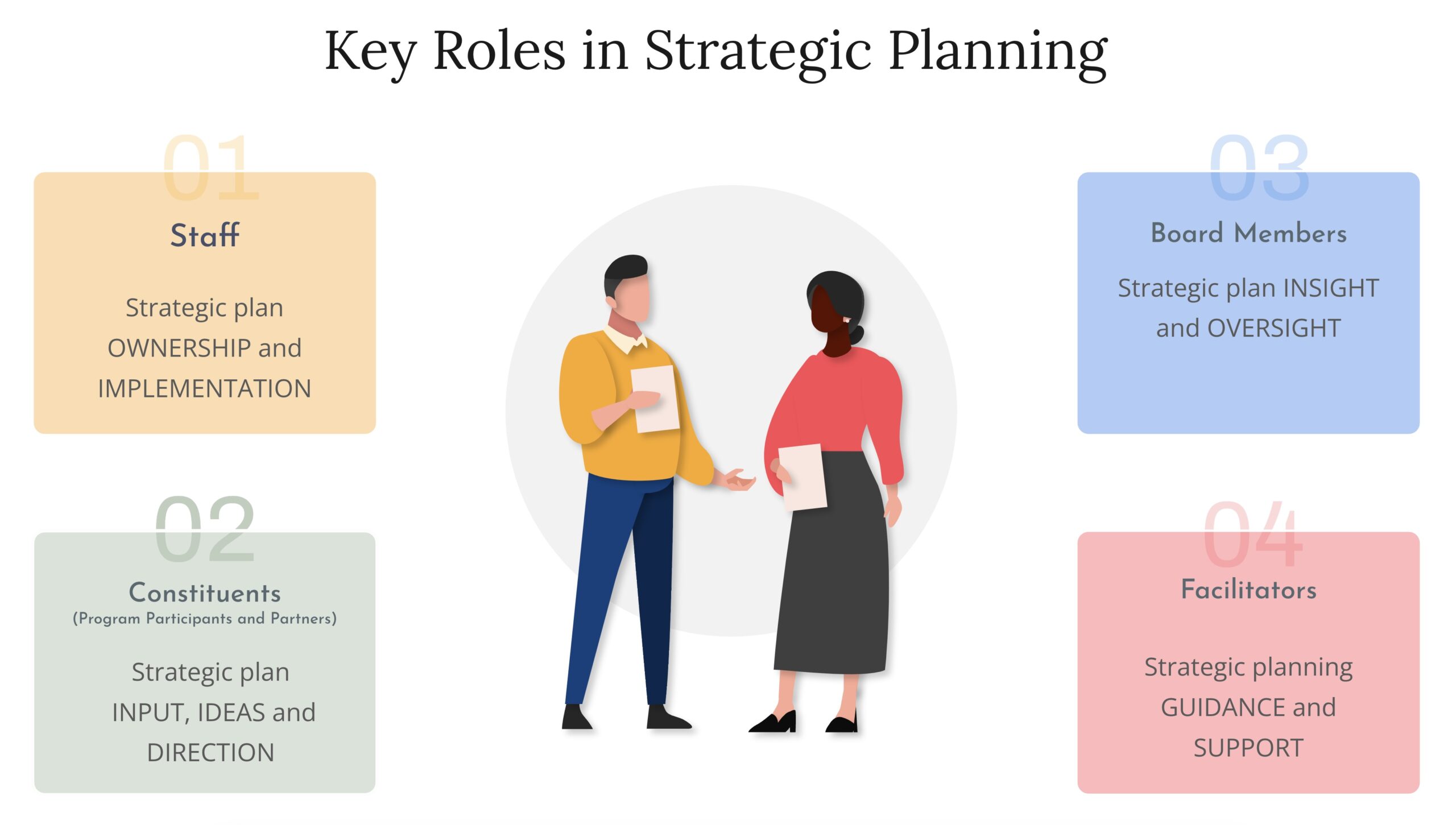A nonprofit strategic planning retreat is a great opportunity to bring your organization’s leadership, staff, board members and constituents together to envision and align around your priorities for the next three to five years. In order to make the most of it, you’ll want to consider:
- How to prepare for the retreat
- Who should attend
- What the agenda should look like
- Where you will be at the end of your two days together
In this post, we’re to breaking down preparing for and conducting your nonprofit’s strategic planning retreat so you can make your next retreat your best one yet.
Preparing for your nonprofit’s strategic planning retreat
Your nonprofit’s successful strategic planning retreat should be in the making before it even starts. Prior to bringing everyone together, we recommend conducting research to understand your nonprofit’s current positioning. Sharing this research with participants at your nonprofit strategic planning retreat ensures everyone is operating off of the same baseline information when making strategic decisions.
This research typically consists of three assessments:
- An organization assessment. This assessment is designed to get everyone at the retreat aligned about where your organization is today. It should provide a high level overview of things such as:
- Current programs
- Demographics served
- Financials and funding streams
- Past strategic planning priorities
- An ecosystem assessment. This is designed to get participants at the strategic planning retreat up to speed on the landscape in which your nonprofit operates. It also provides an overview of other nonprofits in your subsector. The goal of this assessment is help people understand how your nonprofit is similar or different as well as trends within your space.
- A stakeholder assessment. Prior to your retreat, you’ll want to take time to hear from each of your organizations stakeholders and constituents. You can do this through interviews, focus groups, surveys and listening sessions. Your stakeholder assessment elevates your key learnings from this engagement and helps participants at the strategic planning retreat to understand what those who matter most to your organization value about your nonprofit.
While these assessments will likely contain a lot of valuable information, you’ll want to elevate insights that are going to inform your time together at the strategic planning retreat.

Who should attend your nonprofit’s strategic planning retreat?
Dedicating two full days to your nonprofit strategic planning retreat is tall order for most busy board members, nonprofit professionals and constituents. But remember, your strategic plan will guide the success of your organization and mission for the next three to five years. It is worth taking the time to bring everyone together.
But who is everyone who should be included in the planning retreat? Typically we recommend:
- Nonprofit leadership
- A subcommittee of the board
- Nonprofit constituents, or individuals who your nonprofit exists to serve

Many nonprofits also choose to bring in an outside facilitator, who can set the agenda and guide discussions.
What should you do during your nonprofit’s strategic planning retreat?
Retreat Day One
During day one of your nonprofit strategic planning retreat:
- Ground everyone in the key insights from research
- Reaffirm your nonprofit’s vision and mission
- Develop your nonprofit’s purpose statement or Reason For Being
Vision and Mission Reaffirmation
If you’re simply reaffirming your vision in mission, take time to review and discuss each statement. For the vision statement, ask your nonprofit strategic planning retreat participants if they still believe it articulates the world you will create if you meet all of your goals. When it comes to the mission statement, ask participants if they think it articulates the work you do each day to bring your vision to reality.
Vision and Mission Development
If you’re developing a new vision and mission, the first day of your strategic planning retreat is a great time to conduct creative exercises to help the group reimagine these statements.
For help, refer to our Nonprofit Mission Statements: The Ultimate Guide and Nonprofit Vision Statements: The Ultimate Guide.

Reason for Being
You’ll also want to take time developing your nonprofit’s purpose statement or what we call reason for being. This is a succinct statement that captures the unique impact only your nonprofit can make, and it is based on the key insights from your strategic planning research. It includes:
- Your organization’s WHY?
- Your unique impact
- Your key differentiators
We’ve found this statement to be an incredibly powerful asset that brings an additional level of clarity and focus to nonprofit teams and boards. Working together to create it at your strategic planning retreat produces important discussions about where your nonprofit is today and your goals and priorities for the future.
Retreat Day Two
Your goal for day two of your nonprofit strategic planning retreat is to develop your strategic plan pillars and objectives.
Begin the day by reflecting back on the first day of your nonprofit strategic planning retreat. Then, move into envisioning what success looks like for your nonprofit over the next three to five years.
Consider asking a question like: It’s three years from today, and you’re really happy with your progress. What’s had to have happened to make you so happy? This brings participants of the strategic planning retreat into the state of future visioning. You might hear things such as:
- We’ve achieved financial sustainability
- We’ve adopted an evidence-based measurement tool for our programs
- We’ve expanded to reach more people in more communities
- We’re recognized as a leader in homelessness prevention
- We have a board that is representative of the communities we serve
- We’ve created an endowment
- People know about who we are, what we do and why it is important
- We’ve rebranded
- We have better staff retention
- We have staff professional development programs
Then, brainstorm what would need to happen to bring that vision to a reality. Categorize your brainstorm into themes and consider using a tool, like the Eisenhower Matrix to discern what you MUST should from what you COULD do.
By the end of the second day of your nonprofit strategic planning retreat, you should have your plan pillars and a good start on your plan objectives.
Concluding your strategic planning retreat and next steps
In summary, your retreat should include your leadership staff, board subcommittee and constituents. On the first day, you will reaffirm or develop your mission and vision statements, along with your reason for being. On the second day, you will envision what your organization will look like three years from today, what you need to do to get there, what your priorities will be and how you will know if you’ve achieved them.
At the conclusion of your nonprofit’s strategic planning retreat, you can all celebrate that this important part of the process is done. Any strategic planning retreat can be mentally exhausting because the work you’re doing is so important to your nonprofit’s mission.
However, it’s important following the retreat to take the strategic plan pillars and objectives back to stakeholders for their thoughts and insights before finalizing them.
Then, you will move on to creating key results that help you track and measure your strategic plan’s progress.
If you’re looking for a strategic planning partner, we can help.